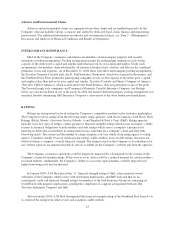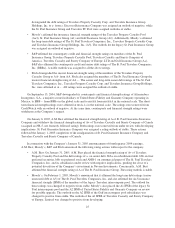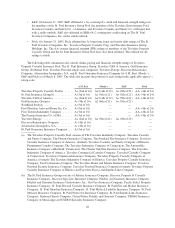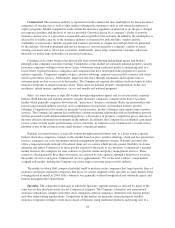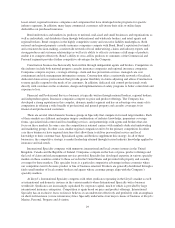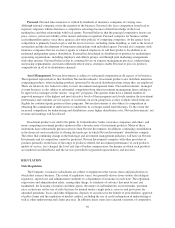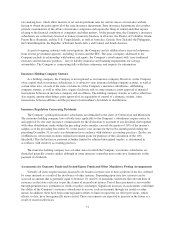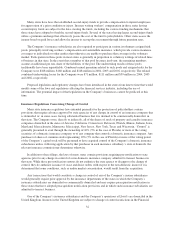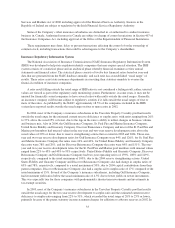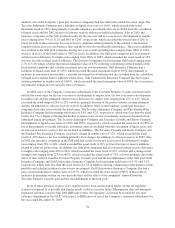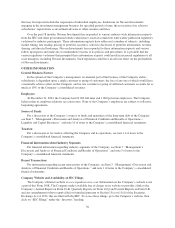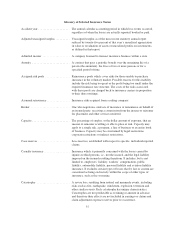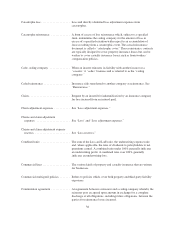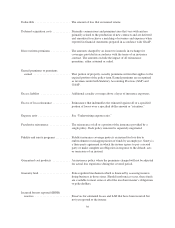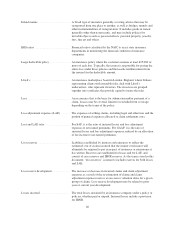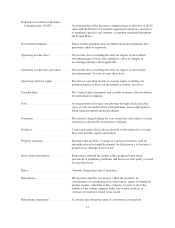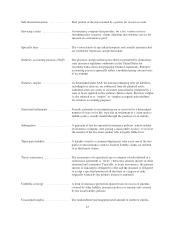Travelers 2004 Annual Report Download - page 45
Download and view the complete annual report
Please find page 45 of the 2004 Travelers annual report below. You can navigate through the pages in the report by either clicking on the pages listed below, or by using the keyword search tool below to find specific information within the annual report.Services and Markets Act of 2000 including approval of the Financial Services Authority. Insurers in the
Republic of Ireland are subject to regulation by the Irish Financial Services Regulatory Authority.
Some of the Company’s other insurance subsidiaries are domiciled in, or authorized to conduct insurance
business in, Canada. Authorized insurers in Canada are subject to change of control restrictions in Section 407 of
the Insurance Companies Act, including approval of the Office of the Superintendent of Financial Institutions.
These requirements may deter, delay or prevent transactions affecting the control of or the ownership of
common stock, including transactions that could be advantageous to the Company’s shareholders.
Insurance Regulatory Information System
The National Association of Insurance Commissioners (NAIC) Insurance Regulatory Information System
(IRIS) was developed to help state regulators identify companies that may require special attention. The IRIS
system consists of a statistical phase and an analytical phase whereby financial examiners review annual
statements and financial ratios. The statistical phase consists of twelve key financial ratios based on year-end
data that are generated from the NAIC database annually, and each ratio has an established “usual range” of
results. These ratios assist state insurance departments in executing their statutory mandate to oversee the
financial condition of insurance companies.
A ratio result falling outside the usual range of IRIS ratios is not considered a failing result; rather, unusual
values are viewed as part of the regulatory early monitoring system. Furthermore, in some years, it may not be
unusual for financially sound companies to have several ratios with results outside the usual ranges. Generally,
an insurance company will become subject to regulatory scrutiny if it falls outside the usual ranges of four or
more of the ratios. As published by the NAIC, approximately 18.5% of the companies included in the IRIS
system have reported results outside the usual range on four or more ratios in 2002.
In 2004, most of the Company’s insurance subsidiaries in the Travelers Property Casualty pool had results
outside the usual range for the estimated current reserve deficiency to surplus ratio, with ratios ranging from 26%
to 37% above the usual 25% or lower, due to the lags in the ratio’s ability to reflect changes in business volume
and business mix. Also in 2004, the Gulf Insurance Company, St. Paul Fire and Marine Insurance Company,
United States Fidelity and Guaranty Company, Discover Reinsurance Company and most of the St. Paul Fire and
Marine pool members had unusual values in the one-year and two-year reserve development ratios above the
usual values of 20% or lower, due to reserve strengthening actions that occurred in 2003 and 2004. Those one-
year and two-year reserve development ratios for Gulf Insurance Company were 44% and 126%, for St. Paul Fire
and Marine Insurance Company the ratios were 24% and 40%, for United States Fidelity and Guaranty Company
the ratios were 78% and 29%, and for Discover Reinsurance Company the ratios were 64% and 151%. The one-
year and two-year reserve development ratios for the St. Paul Fire and Marine pool members with unusual values
ranged from 22% to 45% and 40% to 93% respectively. United States Fidelity and Guaranty Company, Discover
Reinsurance Company and Gulf Insurance Company had two-year operating ratios of 159%, 108% and 149%,
respectively, compared to the usual maximum of 100%, due to the 2004 reserve strengthening actions. United
States Fidelity and Guaranty Company and Discover Reinsurance Company also had change in surplus ratios of
63% and 78%, respectively, compared to a usual maximum of 50%, due to 2004 capital contributions from their
parent companies. Discover Reinsurance Company also had a surplus aid to surplus ratio of 17% compared to the
usual maximum of 15%. Several of the Company’s insurance subsidiaries, including Gulf Insurance Company,
had investment yield ratios below the usual minimum ratio of 4.5% due to lower yields on newer investments.
This was especially true for those companies with predominately shorter term investments and investments in
tax-exempt securities.
In 2003, most of the Company’s insurance subsidiaries in the Travelers Property Casualty pool had results
outside the usual range for the two-year reserve development to surplus ratio and the estimated current reserve
deficiency to surplus ratio ranging from 22% to 51%, which exceeded the usual range of 20% to 25% or lower,
primarily because of the pretax statutory income statement charges for additions to asbestos reserves in 2002. In
33


